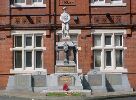
Newton-le-Willows and
Earlestown War Memorial

| OTHER WARS |
 |
Newton-le-Willows andEarlestown War Memorial |
 |
| The
Great War Roll of Honour |
|||||||||||||||||||||||||

Private Barcroft’s father, Mr. J. Barcroft, lived at 73,
Haydock Street, Earlestown. However, although a native of Earlestown, most of
James’s latter years were spent abroad. As a boy he attended the Wargrave
School, and his apprenticeship was served in the paint shop of the Viaduct Works,
after which he emigrated to America. He put in some seven years there, and then
returned to Earlestown where he worked for another twelve months at the Viaduct
Works. He did not settle and eventually went to Australia where he had lived
for about five years when war broke out. He enlisted in the Australian Forces.
According to the NEG of 9th February 1916 and WG of the following day, the news
of his death from a shell in the trenches was received in a letter from Will
Brunt:
“I am writing to let you know that your son, Jim, has been killed in action.
Jimmy and myself were great chums. He was a great soldier, though small, and
always did his bit with the best of us. We were in the front line of trenches
when it happened. I am pleased to say Jimmy never suffered any pain, and I saw
that he was buried properly.”
James is buried in Bancourt
British Cemetery in Plot V Row K Grave 19, Barcourt being a village approximately
4 kilometres east of Bapaume. Apart from a handful buried in September 1918,
most of the cemetery was made by the concentration of graves from the battlefields
East and South of Bancourt and from certain British and German cemeteries. There
are now nearly 2,500 1914-18 war casualties commemorated on the site, over half
of which are unidentified.
Being a member of the Australian Forces, his roll
of honour form has survived. This has a lot of interesting detail, including
the fact that James served under the name of 'Bancroft' rather than Barcroft.